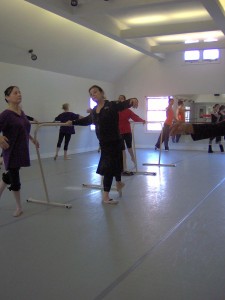This month’s blog — reprinted from pointetilyoudrop.com — is written by amateur dancer, Johanna from Helsinki, Finland:
“In January 1991, I took my first ballet class ever. It was love at first tendu. This month I’m celebrating my 20-year ballet anniversary. That is right, my math is not wrong. Not if I discount the three years when I did not dance at all. I wish I could undo the not-dancing, but at least I figured it out eventually. Ballet is where my heart is. I returned to class in 2006, and haven’t looked back since. Except for today, when I went rummaging in my old calendars/diaries. This is what I wrote down in January 1994: “After class Jill (my teacher) asked me when I was going to get myself pointe shoes. I told her that I was too old to go on pointe.” At the time, I was 24 years young. Can you believe it? It’s a good thing that dance keeps you young, or in my case, progressively younger.
It’s a cliche, but the years do fly by. Life rarely goes as planned (another cliche, sorry). This is why I’ve always appreciated the time-honored tradition of ballet. Over the years, the steps and positions have become familiar, the French understandable, the movement ingrained in both body and mind. Yet, there’s always change. For me, this is probably the best part of learning and dancing ballet. As long as I keep an open mind and never settle for less than my full potential, I keep moving on. That first class was my point of departure, and I’ve been dancing without a destination ever since. I like to think that I’m always halfway there. Because as an adult dancer, class itself is the beginning and end. For professional dancers, it’s all about the performance, dancing on stage in front of a real audience. For us, it’s mostly an imaginary audience behind the class mirror. We love to do the hard work, but it’s not payed work. Unless you count joy as the ultimate reward. I’m pretty sure that most of us adult dancers do just that. We dance because dance brings us joy.
Another reason why I never lost my love for dance: awesome teachers. I will skip the math on this one, but I do remember them all. Your first ballet teacher you never forget. If you are lucky, she’s the one who will instill a love and respect for the art. Jill Miller gave me a solid foundation to build on, and an understanding of how placement works. It was not the Vaganova-school that is so common here in Finland, but it was very safe on untrained adult joints and limbs. I loved her classes, the way she phrased the exercises to music, and the challenges she threw at us. “Move! Dance!” We were told to use the whole space, and not to hold back. “Don’t dance like you have a stick up your butt!” Or, somewhat more eloquent: “Be organic in your movement.” She was one of a kind. Strict, but caring. I’m happy that I got back to ballet and Jill’s classes before her untimely death in 2007.
You do not necessarily have to like your teacher, as long as you learn and enjoy the dancing. However, sometimes it can happen that the class just does not feel right, which has happened to me on occasion. It can be a simple matter of chemistry, or the lack thereof. I still took the classes, learned the steps and worked on my technique. But in the long run, the physical work alone is not enough. Like I wrote earlier, we are in it for the joy. If you enter class with a positive attitude, energy and focus, you should leave class feeling like a million bucks. Sweaty, energized and happy. Of course we all have bad days, certain insecurities and flaws… Nobody can be a perfect student all the time.
I also take classes where there’s almost no interaction between a student and teacher. You know, some teachers give a short warm-up barre and a dancey center, but hardly any personal feedback. That’s okay, especially when you get plenty of corrections elsewhere. In those classes, I often think less about technique and focus on the dancing alone. Over the past 20 years, I’ve learned that both ways work for me, as long as one outweighs the other. In any case, variety in school and style is a wonderful thing. You get fresh perspectives, familiar corrections are rephrased (= eureka!), and you get to work on new exercises and enchaînements.
I have learned from every teacher I’ve ever had. Some focus more on pirouettes, others have awesome petit allegro or a very lyrical adagio. There’s been Vaganova, French School, Cecchetti, RAD, Balanchine and Bournonville, and a mix of schools, styles and teachers’ personal experiences. Some have been wonderful, some a little scary, others easy-going and very nice. Most have been motivating, even inspiring. All have been professional, skilled and knowledgeable. Many have been very important to me. Still are.
When I’m in class, I need to feel both challenged but also safe to make mistakes. I like to be pushed, but preferably in a positive and encouraging manner. I like to get feedback, lots of corrections and guidance. Some praise is nice too. I was already lucky when I started classes with Jill. I can’t think of a better teacher for that time in my life. I’m even more fortunate now. Since I started taking class with my current teacher, Marie-Pierre Greve, so much has changed. Ballet feels like a new experience, yet again. I love Madame’s elegant and beautiful dancing, her generous and attentive style of teaching, her keen eye for the tiniest of detail (which can make a huge difference), the emphasis on quality and artistry, the positive and encouraging class atmosphere, the real work we do and the fun we have in class. It’s pure and undiluted ballet joy!
Where ballet is concerned, I consider myself a very lucky person. Between that first class and the latest one, there has been a lot of dancing: thousands and thousands of classes. So many wonderful and memorable experiences. Sure, there have also been injuries and struggles and breaks. But for the most part, it’s been all good. Amazing, in fact. I would not trade this experience for anything.”

